Abstract
Microvascular erythrocyte sequestration, the characteristic pathological feature of falciparum malaria, was evaluated using a mathematical model in 46 patients with severe infections. From admission radioisotopic circulating red cell volumes and simultaneous venous hematocrits, the model-derived sequestrum hematocrit (mean [95% confidence limits]: 0.70 [0.43-0.97], n = 29) was twice that of peripheral blood (0.33 [0.30-0.36]). Serial reticulocyte and radiolabeled erythrocyte counts indicated that small numbers of cells enter the circulation during initial therapy. The mean fall in hematocrit over 84 h in 26 nontransfused patients conformed to a three-term equation. A first-order decline (t1/2 2.0 h [0.6-3.4]) suggested an average 7.5% plasma volume expansion through rehydration. A zero-order 6.3% (3.1-9.5) fall (t1/2 25.7 h [21.2-30.2]) occurred contemporaneously with a fall in mean parasitemia from 4.5% (3.6-5.4); from these data the model-derived average sequestered erythrocyte volume (4.8% of the admission hematocrit) was similar to the peripheral parasite burden. A second, first-order fall (t1/2 1,047 h [278-1,816]) indicated loss of uninfected erythrocytes with mean lifespan 62 d. Predicted total plasma volume expansion during initial therapy (21.2%) was similar to radioisotopic estimates in 11 patients (17.3% [2.0-33.1]). Application of the model to individual patient data showed wide variations in relative proportions of circulating and sequestered parasitized cells. The model provides evidence of the nature and fate of all parasitized erythrocytes in malaria.
Full text
PDF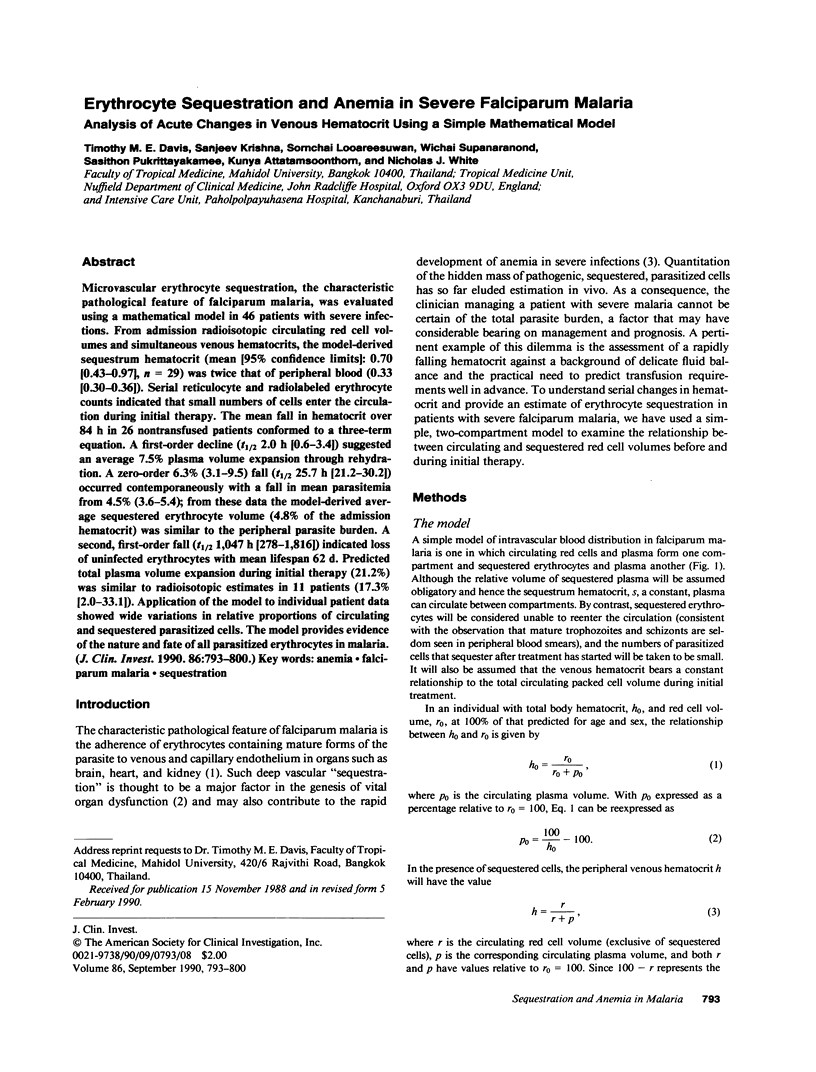
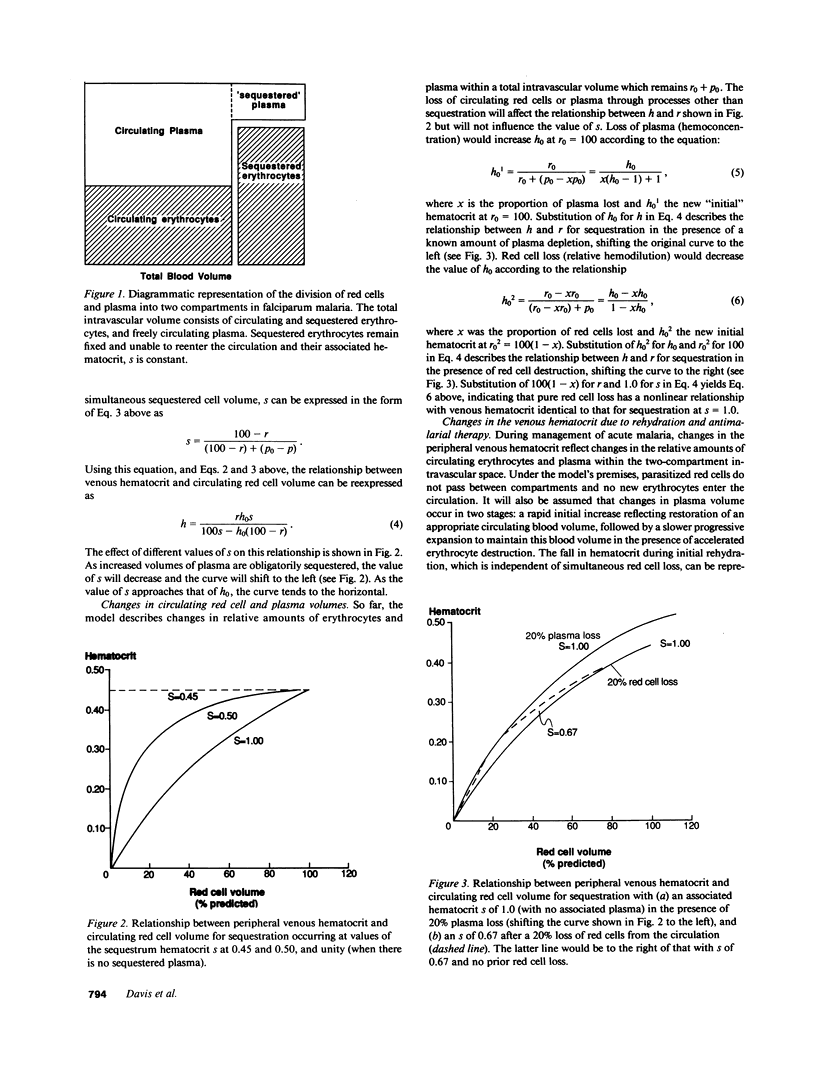
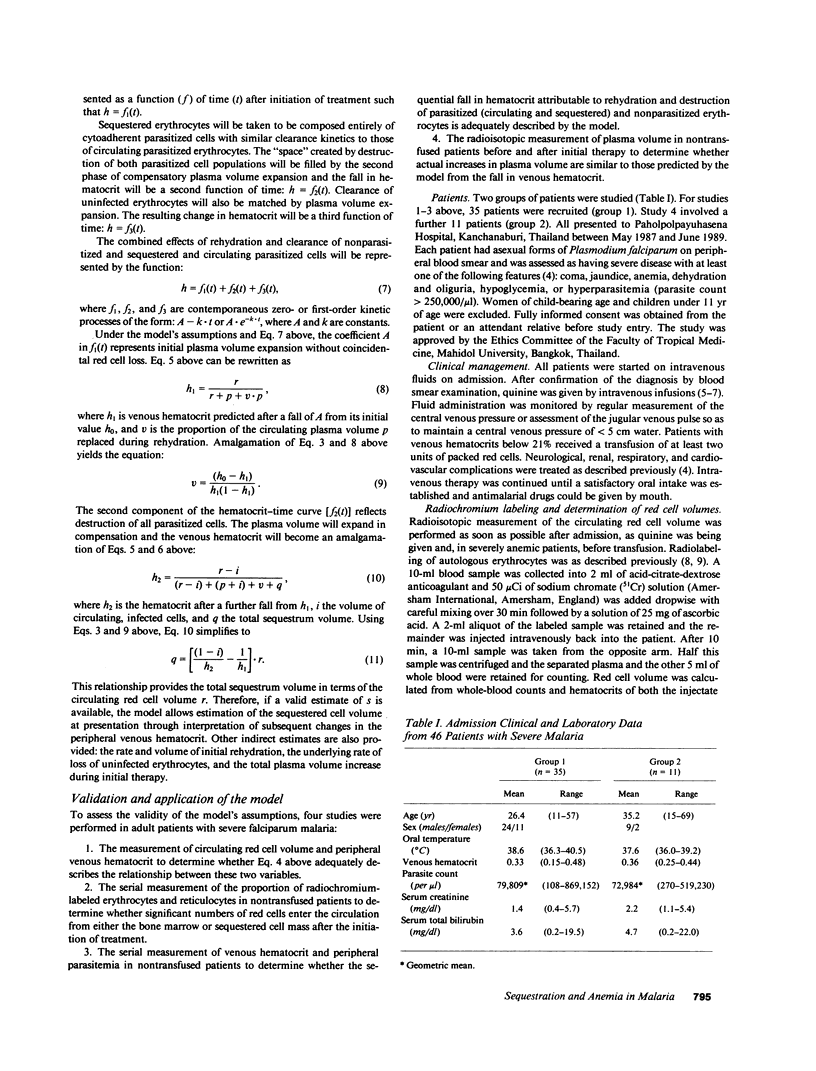
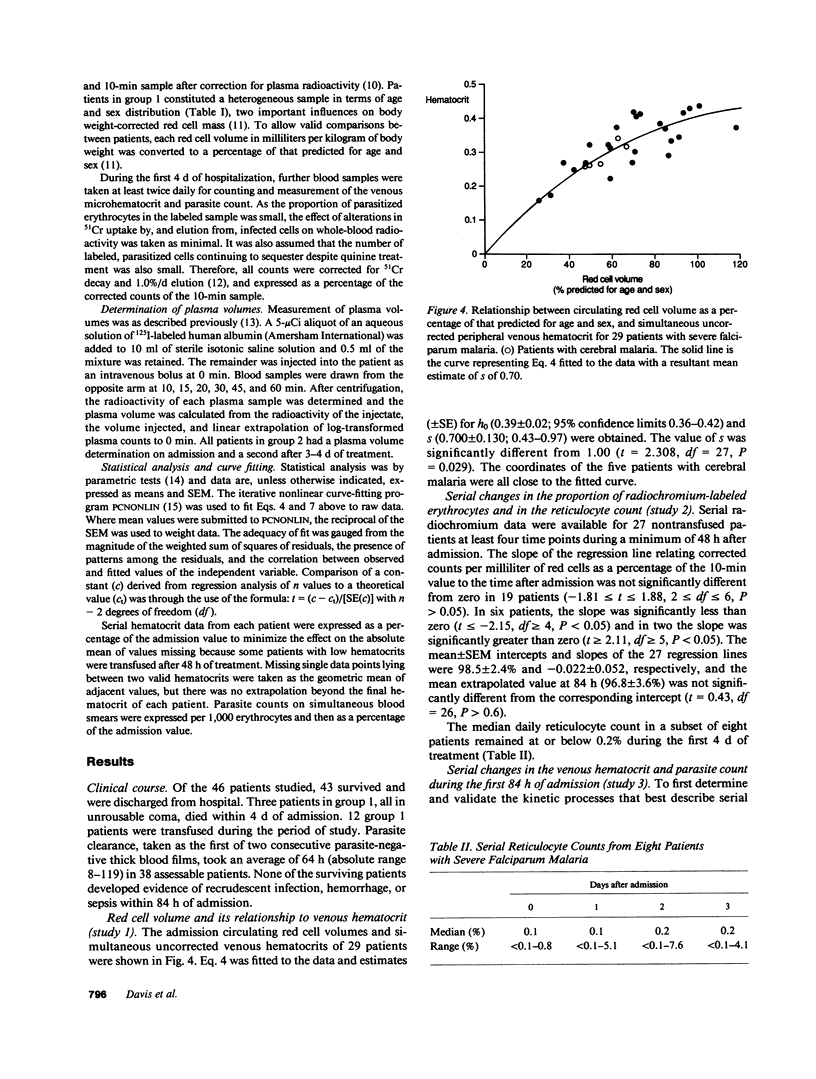
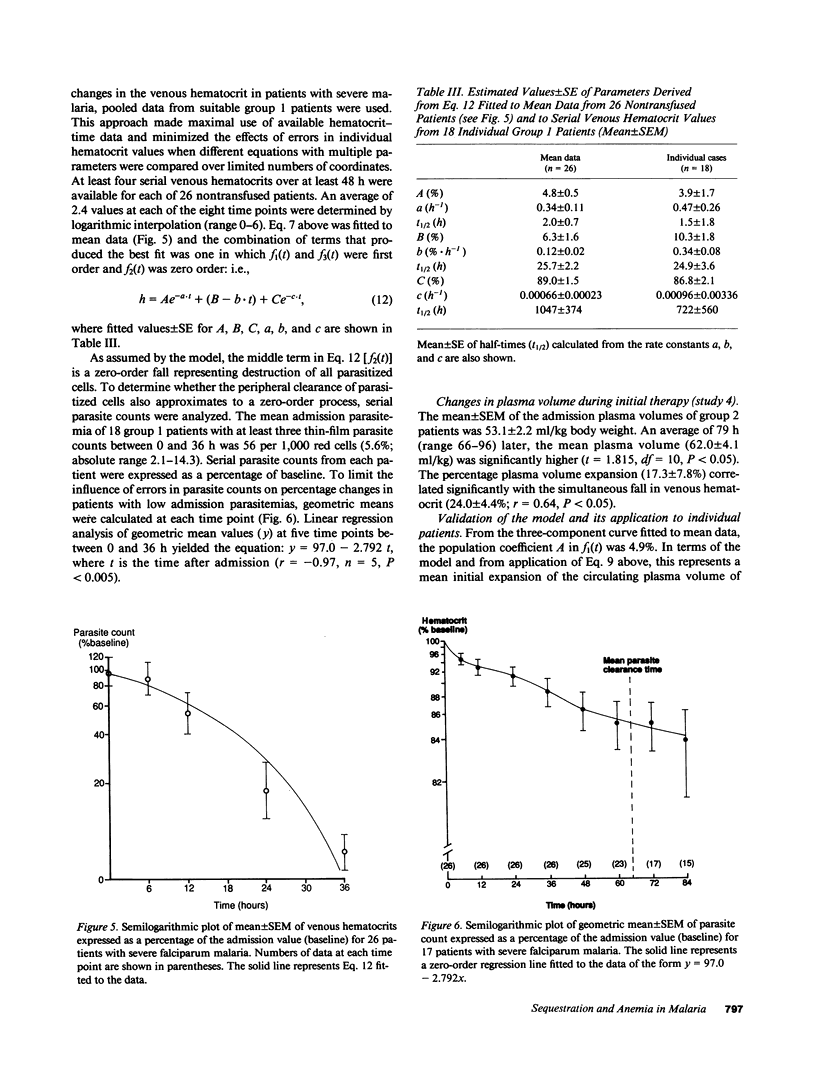
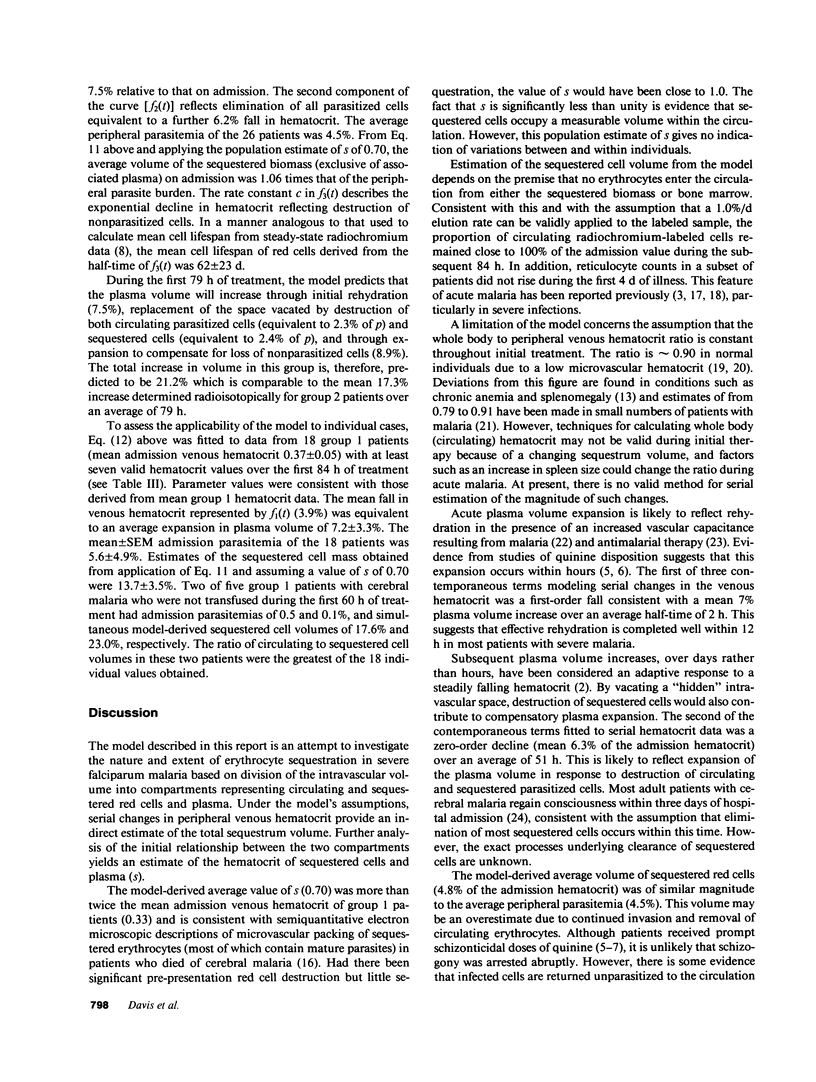
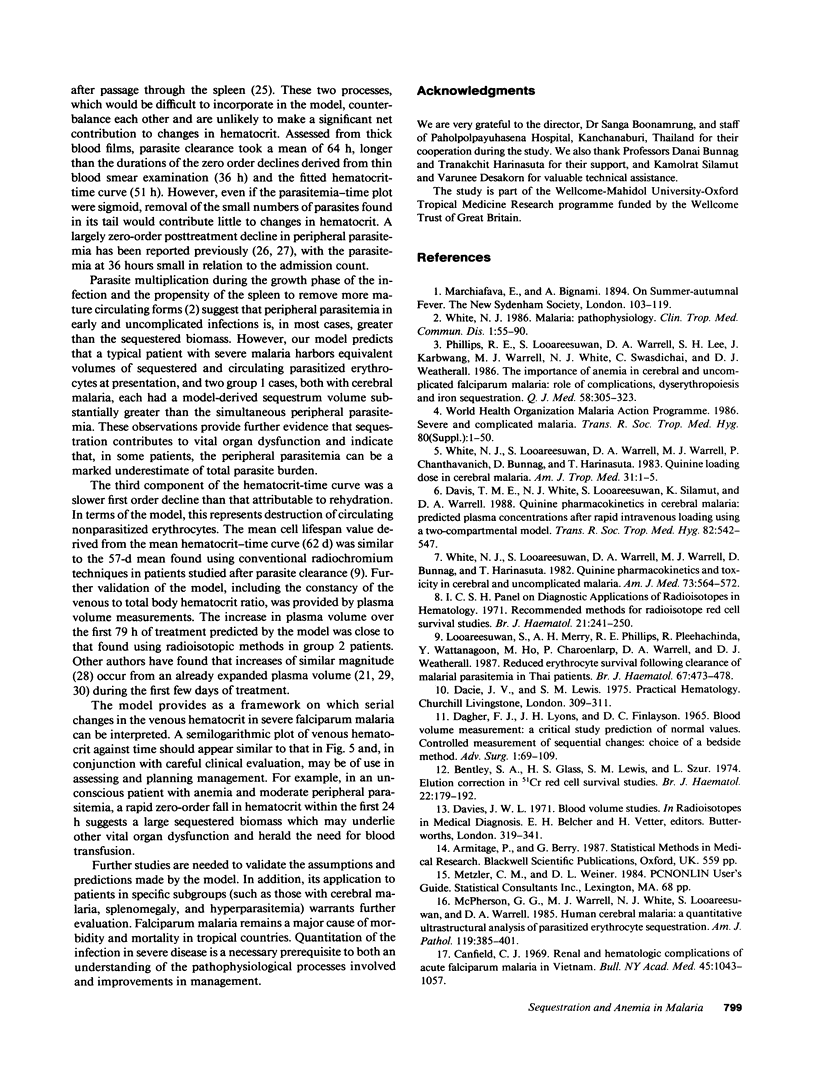
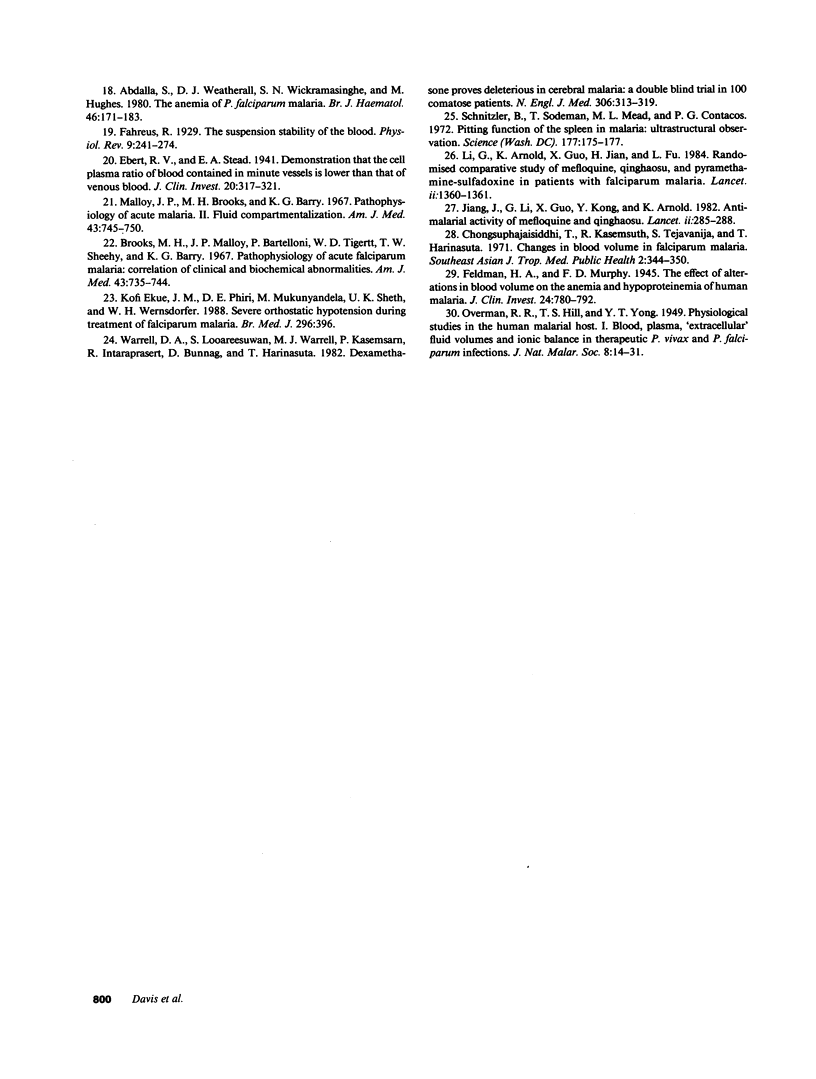
Selected References
These references are in PubMed. This may not be the complete list of references from this article.
- Abdalla S., Weatherall D. J., Wickramasinghe S. N., Hughes M. The anaemia of P. falciparum malaria. Br J Haematol. 1980 Oct;46(2):171–183. doi: 10.1111/j.1365-2141.1980.tb05956.x. [DOI] [PubMed] [Google Scholar]
- Bentley S. A., Glass H. I., Lewis S. M., Szur L. Elution correction in 51Cr red cell survival studies. Br J Haematol. 1974 Feb;26(2):179–184. doi: 10.1111/j.1365-2141.1974.tb00461.x. [DOI] [PubMed] [Google Scholar]
- Brooks M. H., Malloy J. P., Bartelloni P. J., Tigertt W. D., Sheehy T. W., Barry K. G. Pathophysiology of acute falciparum malaria. I. Correlation of clinical and biochemical abnormalities. Am J Med. 1967 Nov;43(5):735–744. doi: 10.1016/0002-9343(67)90115-5. [DOI] [PubMed] [Google Scholar]
- Canfield C. J. Renal and hematologic complications of acute falciparum malaria in Vietnam. Bull N Y Acad Med. 1969 Oct;45(10):1043–1057. [PMC free article] [PubMed] [Google Scholar]
- Chongsuphajaisiddhi T., Kasemsuth R., Tejavanija S., Harinasuta T. Changes in blood volume in Falciparum malaria. Southeast Asian J Trop Med Public Health. 1971 Sep;2(3):344–350. [PubMed] [Google Scholar]
- Dagher F. J., Lyons J. H., Finlayson D. C., Shamsai J., Moore F. D. Blood volume measurement: a critical study prediction of normal values: controlled measurement of sequential changes: choice of a bedside method. Adv Surg. 1965;1:69–109. [PubMed] [Google Scholar]
- Davis T. M., White N. J., Looareesuwan S., Silamut K., Warrell D. A. Quinine pharmacokinetics in cerebral malaria: predicted plasma concentrations after rapid intravenous loading using a two-compartment model. Trans R Soc Trop Med Hyg. 1988;82(4):542–547. doi: 10.1016/0035-9203(88)90498-1. [DOI] [PubMed] [Google Scholar]
- Ebert R. V., Stead E. A. DEMONSTRATION THAT THE CELL PLASMA RATIO OF BLOOD CONTAINED IN MINUTE VESSELS IS LOWER THAN THAT OF VENOUS BLOOD. J Clin Invest. 1941 May;20(3):317–321. doi: 10.1172/JCI101225. [DOI] [PMC free article] [PubMed] [Google Scholar]
- Feldman H. A., Murphy F. D. THE EFFECT OF ALTERATIONS IN BLOOD VOLUME ON THE ANEMIA AND HYPOPROTEINEMIA OF HUMAN MALARIA. J Clin Invest. 1945 Nov;24(6):780–792. doi: 10.1172/JCI101664. [DOI] [PMC free article] [PubMed] [Google Scholar]
- Jiang J. B., Li G. Q., Guo X. B., Kong Y. C., Arnold K. Antimalarial activity of mefloquine and qinghaosu. Lancet. 1982 Aug 7;2(8293):285–288. doi: 10.1016/s0140-6736(82)90268-9. [DOI] [PubMed] [Google Scholar]
- Kofi Ekue J. M., Phiri D. E., Mukunyandela M., Sheth U. K., Wernsdorfer W. H. Severe orthostatic hypotension during treatment of falciparum malaria. Br Med J (Clin Res Ed) 1988 Feb 6;296(6619):396–396. doi: 10.1136/bmj.296.6619.396. [DOI] [PMC free article] [PubMed] [Google Scholar]
- Li G. Q., Arnold K., Guo X. B., Jian H. X., Fu L. C. Randomised comparative study of mefloquine, qinghaosu, and pyrimethamine-sulfadoxine in patients with falciparum malaria. Lancet. 1984 Dec 15;2(8416):1360–1361. doi: 10.1016/s0140-6736(84)92057-9. [DOI] [PubMed] [Google Scholar]
- Looareesuwan S., Merry A. H., Phillips R. E., Pleehachinda R., Wattanagoon Y., Ho M., Charoenlarp P., Warrell D. A., Weatherall D. J. Reduced erythrocyte survival following clearance of malarial parasitaemia in Thai patients. Br J Haematol. 1987 Dec;67(4):473–478. doi: 10.1111/j.1365-2141.1987.tb06171.x. [DOI] [PubMed] [Google Scholar]
- MacPherson G. G., Warrell M. J., White N. J., Looareesuwan S., Warrell D. A. Human cerebral malaria. A quantitative ultrastructural analysis of parasitized erythrocyte sequestration. Am J Pathol. 1985 Jun;119(3):385–401. [PMC free article] [PubMed] [Google Scholar]
- Malloy J. P., Brooks M. H., Barry K. G. Pathophysiology of acute falciparum malaria. II. Fluid compartmentalization. Am J Med. 1967 Nov;43(5):745–750. doi: 10.1016/0002-9343(67)90116-7. [DOI] [PubMed] [Google Scholar]
- OVERMAN R. R., HILL T. S., WONG Y. T. Physiological studies in the human malarial host; blood, plasma, extracellular fluid volumes and ionic balance in therapeutic P. vivax and P. falciparum infections. J Natl Malar Soc. 1949 Mar;8(1):14–31. [PubMed] [Google Scholar]
- Phillips R. E., Looareesuwan S., Warrell D. A., Lee S. H., Karbwang J., Warrell M. J., White N. J., Swasdichai C., Weatherall D. J. The importance of anaemia in cerebral and uncomplicated falciparum malaria: role of complications, dyserythropoiesis and iron sequestration. Q J Med. 1986 Mar;58(227):305–323. [PubMed] [Google Scholar]
- Schnitzer B., Sodeman T., Mead M. L., Contacos P. G. Pitting function of the spleen in malaria: ultrastructural observations. Science. 1972 Jul 14;177(4044):175–177. doi: 10.1126/science.177.4044.175. [DOI] [PubMed] [Google Scholar]
- Warrell D. A., Looareesuwan S., Warrell M. J., Kasemsarn P., Intaraprasert R., Bunnag D., Harinasuta T. Dexamethasone proves deleterious in cerebral malaria. A double-blind trial in 100 comatose patients. N Engl J Med. 1982 Feb 11;306(6):313–319. doi: 10.1056/NEJM198202113060601. [DOI] [PubMed] [Google Scholar]
- White N. J., Looareesuwan S., Warrell D. A., Warrell M. J., Bunnag D., Harinasuta T. Quinine pharmacokinetics and toxicity in cerebral and uncomplicated Falciparum malaria. Am J Med. 1982 Oct;73(4):564–572. doi: 10.1016/0002-9343(82)90337-0. [DOI] [PubMed] [Google Scholar]
- White N. J., Looareesuwan S., Warrell D. A., Warrell M. J., Chanthavanich P., Bunnag D., Harinasuta T. Quinine loading dose in cerebral malaria. Am J Trop Med Hyg. 1983 Jan;32(1):1–5. doi: 10.4269/ajtmh.1983.32.1. [DOI] [PubMed] [Google Scholar]


